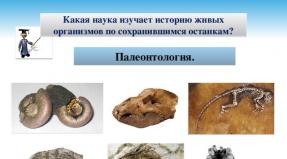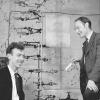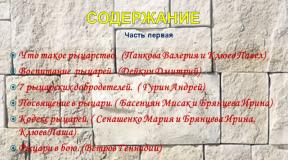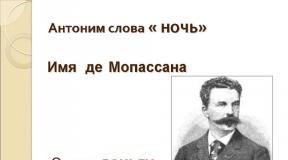Money is a means of exchange, purchases, payments, class hour. Class hour "Pocket money". The teacher concludes what the most money was spent on
Goals: To develop in students the ability to argue their point of view. Foster a culture of discussion.
Form: Talk show.
Participants: students of the class, class teacher.
Preparatory stage:
In preparation for the class hour, the class teacher needs to form an initiative group of class students, which will conduct a survey of classmates on the following questions:
— Do you earn money for personal expenses yourself or ask your parents?
— Have you ever had to earn money on your own?
— How do your parents feel about the opportunity for boys and girls to earn money on their own for personal expenses?
— What is most important for you in assessing a person - his moral qualities or material wealth?
In a prepared class, a student can also act as a leader, but after detailed instructions from the class teacher.
Talk show progress.
Leading: Many of you have encountered the problem of pocket money.
A new cell phone, a stereo system, tickets to a concert of your favorite band... There are so many things you want!
You can, of course, ask your parents. If your parents are wealthy enough, this may not be a problem (unless you end up becoming a very spoiled person). What if parents are struggling to make ends meet? Earning money for personal expenses yourself, is it realistic? Do we need to learn now how to make money and how to manage it correctly?
We will try to find out your attitude to these difficult problems during the talk show. (The presenter should emphasize that during the class hour only the problem of legal ways of making money is discussed, and not getting it illegally.)
After summing up the results of the survey, the presenter introduces students to the questions for discussion, which can be written out on a piece of Whatman paper or printed for each student, and invites them to express their opinion on the issues raised (situations of moral choice). Sample questions for a talk show:
— Should high school students receive pocket money and in what quantity?
— Where and how can a high school student earn money?
— Is monetary reward for good studies, help around the house acceptable income?
— Is it possible to combine work with successful studies at school?
— Is parental consent necessary when deciding on the employment of a son or daughter?
— Is it possible to earn big money through honest work?
— Are the concepts of “wealth” and “kindness” compatible?
— Do you agree with the statement of one teenager: “When you earn money yourself, you begin to respect yourself”?
— Do you think that money always spoils a person?
—Can money be a measure of a person’s worth?
— No one dominates the discussion, everyone has the opportunity to express their point of view.
— If you want to speak, raise your hand.
— We treat each other with respect.
— The order of speeches is determined by the presenter, who maintains a neutral position in the discussion.
— Your opinion or position must be supported by facts, examples from life, literature, media, etc.
— Participants listen and hear each other.
After discussing the above issues, the facilitator continues:
- So, let's say you found a way to earn money honestly. The next question is: what to do with them? Agree that learning how to spend your earned money wisely is very important. Think about how you spend the money you earn. Spend it on little things or save it for some big purchase? Do you contribute the money you earn to the family budget? Do you know how to plan your expenses?
The easiest way is to spend money uselessly. There are many temptations, for example, cigarettes, alcohol (after all, you earned the money yourself, and you don’t always want to think about the consequences). And if you want to learn how to spend money wisely, try writing down all your income and expenses for about two weeks, down to your last piece of gum and ice cream. Now make notes before each item of expense - “was really necessary” or “just wanted.” This way you will find out where your money is going and how to stop spending. If we sit down and try to make a list of things we would like to have, it will probably turn out to be very long. But if we suddenly had all the things we wanted, it is likely that we would soon feel dissatisfied again. Our desires are limitless, and an impossible desire brings a lot of disappointment. We must learn to balance our desires with our capabilities.
In the West, a person begins to learn the art of handling money from early childhood, and learning continues throughout his life. The father is a millionaire, and the son stands at the assembly line and wraps hamburgers, or repairs cars, or sells newspapers, earning money for the holidays. This is not cruelty, not greed, but the norm of life, because money is an educational tool.
As a child, Margaret Thatcher spent all her free time standing behind the counter, but she hardly saw toys or new clothes. It’s just that her father believed that she should achieve everything on her own.
In the 1890s, an electric company in Detroit hired a young mechanic at a measly salary of $11 a week. He worked 10 hours a day, and in the evenings he retired to an old shed. The neighbors called him crazy. After three years of hard work, this guy left the barn in a carriage without a horse. That evening a new industry was born. And the guy's name was Henry Ford.
And one more thing, guys, I would like to dwell on one very important issue.
Unfortunately, the signs of our time have become wealth and poverty. Nowadays it is a very common opinion that money can buy everything, and a person is judged by his financial situation.
But should a person be judged only by his wallet, or should there be something much more important in assessing a person? What is the true value of a person? Do you want to be judged by your cell phone brand?
phone or branded stickers on your clothes? Is this the source of your true value and the criterion of your personality? If your friends only hang out with you because you have money or a super fancy cell phone, what kind of friends are they and what will happen to your friendship if there is no money? Do you agree with the point of view that the true dignity of a person is measured not by wealth, but by his spiritual qualities and character?
If money is a measure of our self-esteem, envy may arise towards those who have more, and envy is a feeling that destroys the human soul. If we look down on those who have less wealth, then there is a direct path to anger, greed, arrogance, and this is no less dangerous for the human soul.
It is important to know: no matter what you do in the future, the most expensive things have no price! For example, health. So save on ice cream or cake, but don't skimp on lunch. Save on super trendy clothes, but don't skimp on a good book or good music that you like.
Remember that money cannot buy a good mood or the respect of loved ones, their love. The famous American basketball player Michael Jordan once remarked: “They say money can buy anything. Lie. Money can’t buy youth.” Don’t impoverish yourself by trying to measure everything in terms of money. Not everything in the world can be bought and sold. Listen to the opinion of the French writer Jean de La Bruyère: “We should not envy the wealth of other people: they acquired it at a price that we cannot afford, they sacrificed peace, health, honor, conscience for it. It's too expensive".
We must remember that it is not money itself that brings happiness, as was believed for many years, but a person’s attitude towards it. You can find a common language with money if you do not make its accumulation the meaning of your entire life, and especially if you do not use dishonest, but very seductive methods for this.
The culture of communicating with money is part of a person’s general culture. It lies in a person’s healthy attitude towards money, should be brought up from childhood and be the basis of positive relationships between people in which money is used in one way or another.
During the discussion, a collective analysis of problems occurs.
A very important stage of the class hour is summing up its results.
Give students the opportunity to express how interesting the conversation was for them, listen to their wishes. If students have difficulties, the class teacher should help them formulate the main conclusions of the class hour.
Note for the class teacher. Discussion as a form of conducting a class hour does not provide the only correct solution to the problem, however, in the collective search for truth, the process of moral assessment and self-assessment, analysis and introspection is stimulated, the basic moral principles are clarified, and the moral values of the participants in the discussion are correlated with universal human values. This form of discussion of problems helps high school students overcome indifference and passivity, and forms their own view of complex life problems.
At the end of the class hour, you can offer students the following test.
Test “Your attitude towards money”
What attracts me in my work is the result, not the process. (1b)
I always pay more attention to the real situation than to my plans. (1b)
Having finished one task, I can easily take on another. (1b)
Money is the most important thing in life. (7b)
I instantly switch from one task to another and easily return to interrupted work. (1b)
I can work 10-12 hours, even if the work is unpleasant for me. (1b)
If I get rich, I will solve all my problems. (7b)
Any company recognizes me as a leader. (5 B)
I don't see a more attractive goal in life than wealth. (4b)
I want to get higher education in the future. (2b)
Poverty is almost always the result of a lack of ability. (1b)
I like to improve lives with my ideas. (1b)
I can make any purchase better, more profitable than others. (5 B)
I'm a good organizer. (5 B)
I don’t need time to “wind up” before work. (1b)
I never forget the things I take on. (1b)
I would rather start my own business than work for someone else. (5 B)
In conflicts, I always get my way. (5 B)
I can't sit idle. (1b)
For normal work, 6 hours of sleep is enough for me. (1b)
If I lose, I immediately start working for revenge. (1b)
Money is necessary to solve any problem. (4b)
I can easily strike up a conversation with anyone. (4b)
No activity attracts me more than making money. (7b)
It's easy for me to make a good impression on people. (3b)
I have a lot of friends. (3b)
I can always get what I need from people. (5 B)
I would love to go to a job where there is a lot of travel. (1b)
I study a foreign language with interest. (1b)
I'm almost never late. (1b)
Interpretation of results.
Less than 6 points. You are unlikely to be successful in business. We still advise you to work on yourself in terms of training your performance and communication techniques; these skills are needed not only by a millionaire.
6-18 points. Your inclinations are quite sufficient for hired work, perhaps in a relatively independent position. In independent business you will face considerable difficulties, do not rush into business like a whirlpool - first learn to swim better.
19-50 points. You can succeed if you attack the "gold mine" or work behind the boss's wide back or in a close-knit team that compensates for your weaknesses.
51-75 points. If you never succeed in business, it will simply be a misunderstanding. Never give up trying - success awaits you.
More than 75 points. It's scary to think about the heights you can reach. However, when entering the first steps of this endless staircase, think about whether you want to pay too high a price for it? Don't forget that there are things more valuable than money.
Students are presented with three terms: “Parents - Pocket - Money.” They are asked to think and answer the following questions:
? What will we talk about in class today?
About pocket money
? What questions can we consider today?
How much money do you need
How often should your parents give them to you?
What should they be spent on?
- Warm up. Continue the offer
Classroom teacher.
Before we do analytical and design work, let's exercise our minds.
Since ancient times, Rus' has had a special attitude towards money. They were spent, given, saved, saved, and lent. Centuries later, the attitude towards them has not changed. But the people expressed their wisdom in the matter of money in proverbs and sayings. Some are known to us from childhood, and some are extremely rare. Let's remember them.
(Students are asked to complete proverbs and sayings)
Don’t have a hundred rubles, but have a hundred (friends).
A penny protects the ruble, and the ruble protects the head.
Money is not like rye, and it grows in winter; money is not ice, and in winter (melts).
Friendship is friendship, but money is apart.
It’s easy (to pay) from someone else’s wallet.
Those who are not rich are happy with a penny, but those who are rich are happy with thousands (not enough).
Extra money is extra (care).
Don’t be sorry for the altyn, otherwise you’ll give it back (half a dime)
It’s not easy to make money, but it’s easy (to live).
The stingy man's ruble is crying, but the generous one's ruble is jumping.
- Project work in groups
- General conversation with students
? Do you need pocket money? What do you need them for?
- What do we have?
Students are asked to conduct a mini-research on the issue “Our pocket money”. Research can be done within a group or with members of other groups. Summarize the results obtained. The group leader announces the result.
Research Questions.
- Do your parents give you money?
- How often do they do this
- Is this money enough for you?
- What do we want to have? Create a business project.
Classroom teacher.
Now try to present your business project on the presented issue. When creating a project, you should take into account its subsequent implementation.
The following questions are suggested to help students:
- Do you need to allocate money?
- How often should this happen?
- How much do you need?
- What will you spend it on?
After discussion and preparation, the group leader presents the project to classmates. Students discuss and ask questions. They determine the most feasible and useful project for them.
- Assess the situation
Classroom teacher.
Not only adults, but also children should have a culture of handling money. I invite you to evaluate how successfully they are doing this.
Situations are given to the groups.
Situation No. 1. When sending their son to summer camp, his parents gave him a cell phone for emergency communication. At the camp, ten-year-old Oleg wanted to earn extra money and allowed his friends to call from his mobile phone. He asked for 10 rubles for one call and did not pay attention to the duration of the conversations. As a result, the child acquired an additional small amount of money. But.
Situation No. 2. Ten-year-old Sasha urgently needed 200 rubles to buy a new game. My parents refused to give me money because Sasha had just recently bought 2 discs.
Then Sasha came up with a business project. He called his brother, a first-grader Mishka, and invited him to play checkers with him for money. The bet is 200 rubles. Naturally, Mishka lost. But.
Situation No. 3. Parents hired eighth-grader Dima an English tutor. The payment to the teacher for lessons was transferred with the boy. A few months later, my son was already shining in his English lessons, but for some reason he didn’t get much sleep. It turned out that he left the tutor a long time ago, studies the language on his own at night, and gives the money at interest to his classmates. Now he is a very successful entrepreneur. But.
Classroom teacher.
You have become acquainted with three business projects. And each of them ends with a big “BUT”. Let's look at how successful these projects are and why doubts remain after them.
Students give an assessment and offer their own solution to the problem.
- Continue the sentence
Classroom teacher.
Now let's turn again to folk wisdom. Is everything in our lives bought and sold? Are there any valuables in the world that cannot be bought?
The groups are asked the following questions in turn:
Can everything be bought with money?
You can buy a watch for money. (but not the time).
You can buy a book for money. (but not wisdom).
Money can buy a bodyguard. (but not a friend).
Money can buy food. (but not appetite).
You can buy a house for money. (but not family).
Money can buy position in society. (but not people's respect).
Money can buy medicine. (but not health).
Money can buy a kiss. (but not love).
Money can buy entertainment. (but not happiness).
You can buy an icon for money. (but not faith).
Money can buy an entire continent. (but not the Motherland).
You can buy an order for money. (but not a feat, not an honor).
Money can buy clowns. (but not in a good mood).
- Does money love you?
Test for students.
1. Imagine that you have a free amount of money. What will you do with it?
a) I will invest in business to make even more money;
b) open a bank account;
c) I will buy the thing of my dreams.
2. How will you feel when you receive an expensive gift?
a) satisfaction;
b) joy;
c) awkwardness.
3. Do you often borrow money from friends?
a) never;
c) systematically.
4. How does information about the dollar exchange rate affect your mood?
a) directly proportional;
b) inversely proportional;
5. Do you follow the law that a poor person buys only good things?
b) how when;
6. Having noticed a ruble coin under your feet, do you decide to pick it up?
a) no, I live by earnings, not by finds;
b) if I am currently “broke”;
c) definitely!
7. Do you like to discuss the price of your own purchases?
a) this topic is closed to me;
b) why not?
c) yes, this is a source of my pride.
8. Do you count your change?
a) mandatory;
b) if I remember;
c) I'm lazy.
CALCULATION OF RESULTS:
Give yourself 3 points for each answer “a”, 2 points for “b” and 1 point for “c”. Sum up the result.
From 19 to 24 points. You are a born financier with a nose for profit, and no financial collapse can make you a beggar. When you lose, you immediately find; falling, you rise. But sometimes money becomes an end in itself for you, and this is already bad...
From 14 to 18 points. You have a difficult relationship with money; they either come in a school, or fly away with a gust of wind... Well, on the other hand, you are freed from the fears characteristic of rich people, and you will always overcome financial difficulties by reducing your costs.
From 8 to 13 points. Money doesn't love you; You're welcome... However, you do them too - which is completely inexplicable for an ordinary person.
- Rules for handling money
Classroom teacher.
Here are some rules. You can add your own.
- Don’t make an idol out of money, don’t put money in the place of God.
- Earn honestly.
- Balance your “I want” and “I can”.
- Do not brag about the money you earn and do not count money in public.
- Try not to get into debt.
- Do not play lotteries or gambling.
Students work on the rules, then read them out.
Summing up the event. Rewarding active participants. Students are given booklets with event materials.
A kopeck saves the ruble.
Once the Hare ran past the house of the Investor Bear, and the Bear was teaching classes at a school for animals. And just at that moment when the Hare was running, Potapych was writing down a very important law on the board. The hare, even though he was cross-eyed, saw with one eye that the bear was writing on the board: “A penny saves the ruble!”
“This is nonsense!” - thought the Hare and rushed on.
And Belka meets him. The hare ran up to her and said: “Squirrel, Squirrel, can you imagine, the Bear invented that a penny saves a ruble! Ha-ha-ha!” - and burst out laughing.
“The Bear says smart things,” Belka thought and galloped on, without answering the Hare.
A Hare runs along the road, laughing, and a Mouse meets him. The Mouse wonders what made the oblique man so happy, he asks him. The Hare, choking with laughter, says: “Our Bear has forgotten how to count, he says that a penny saves a ruble!”
The Mouse climbed onto the Hare’s head and tapped his paw between the ears: “Knock-knock-knock.”
- What are you doing, Mouse! – Kosoy was indignant.
And the Mouse answers him: “Even though you, Hare, are bigger than me, you have less brains in your head. Judge for yourself. One ruble consists of one hundred kopecks. One ruble is equal to one hundred coins of one kopeck, or twenty coins of five kopecks, or ten coins of ten kopecks, or two coins of fifty kopecks. If you have a small wallet, then all the pennies may not fit. And if the store doesn’t have enough money for you, then they won’t sell you anything,” the Mouse continued to explain to the Hare.
But the Hare only waved his head in response: “Come on, it’s better, Mouse, to swing with you on the swing.” The Wolf opened an amusement park for everyone. But first I’ll treat you to ice cream.” And the friends ran.
The Hare is running, and on his side his bag is dangling, into which he put four rubles in different coins. The mouse runs nearby. The Hare will look at the Mouse, smile and quickly run the race. The little mouse got tired of chasing the Hare and grabbed his purse with his teeth. But the mouse had sharp teeth, so he tore it and made a hole. And a coin fell out of that hole. No one noticed this, neither the Hare nor the Mouse. Only the Tinkling Fly.
The Mouse and the Hare came running to the Wolf Amusement Park. The fox is right there, selling ice cream. The Hare approached the Fox and said: “The Mouse and I have two ice creams on a stick! Yes, with chocolate for me, and with nuts for the Mouse. I'm giving him a treat today! He believes Bear’s nonsense about a penny.”
The fox wagged its tail: “That’s two rubles for you.”
The Hare took out two coins of fifty kopecks and ten coins of ten kopecks and gave them to the Fox. The fox gave out two ice cream popsicles. One with nuts inside, the other just covered in chocolate.
Friends enter the park, and the Wolf sells tickets at the entrance. The Hare gives twenty coins of five kopecks to buy a ticket for a friend. The mouse took the ticket and ran on the slide, and the Hare poured all the remaining money straight from his wallet into the Wolf’s paws. The wolf counted them and said: “The ticket costs one ruble, but here it’s ninety-nine kopecks. There’s not enough money, there’s no ticket!”
The hare began to be indignant and rebel: “Just think, one penny is missing!”
And the Wolf clicked his teeth and answered: “No, you won’t think so! A penny saves the ruble! If you let one Hare through without a ticket, many other hares will come running. Look, there are so many of you running around in the forest, a whole hundred of you!”
Here the Hare sits, watching the Mouse swing on a slide or swing, and he thinks: “If only I had one more penny!” I would add this kopeck to the ninety-nine that I have in my wallet, and it would become a hundred kopecks. And one hundred kopecks is already a whole ruble. Now I don’t have a ruble. Therefore, there is not enough money for a ticket to the park. It turns out that Bear was right: “A penny saves a ruble.”
























 Back forward
Back forward
Attention! Slide previews are for informational purposes only and may not represent all the features of the presentation. If you are interested in this work, please download the full version.
During the classes
1. Organizational moment.
2. Communicate the topic and objectives of the lesson. Slide
Well, what can we say about the first syllable? Slide
It is known about him, thank God,
What is the antonym of the word "night"
And the ghost drives away.
The second syllable - ask mom,
Frenchman, author of novels,
Mustachioed de Maupassant,
Everyone is called by name.
And what kind of word came out here?
What do you get on payday?
What do pirates hide in chests?
What are the candies sold for?
Students: money.
Showing an excerpt from the cartoon "Dunno on the Moon" (part 2, where Dunno asks the question: what is money?)
Teacher: What question does Dunno ask? (What is money?)
We have been looking for the answer to this question and many others related to money and the ability to handle it for a month. To do this, we divided into groups and each group did a little research and found a lot of interesting things. And the result of our work was the book “A penny saves the ruble”
Section 1 of our book is the introduction.
Let's listen to the guys from group 1.
So, over to the first group.
We were looking for an answer to the question:
– what is money
- history of money creation
– ruble exchange rate.
Money is a measure of the value of a good or service when buying and selling. Money is used to exchange, make payments, measure value, and accumulate capital. Money can be metal and paper. Each banknote has its own denomination.
Student 1: Functions of money.
-
Medium of exchange
- Measuring instrument
- Store of value
- Instrument of payment
Student 2: Slide. Several thousand years ago people did not know what money was. They simply exchanged various objects with each other. Potters changed pots and jugs, blacksmiths changed arrowheads, knives, and axes. Farmers - grain, vegetable oil, cattle breeders - bulls, sheep, wool and leather. Victorious warriors - their captives. But exchanging goods is very difficult. The value of things and products is different. For example, for one ram you could get two axes or four jugs. To make exchange easier, people invented money. True, at first various objects served as money, such as sea shells, animal skins and even dried fish. They were gradually replaced by coins and paper money.
Student 3: So, money replaced natural exchange, when people simply exchanged goods with each other. Money turned out to be a very convenient thing: they were taken in exchange for anything, they did not deteriorate during long-term storage. The first prices appeared - a certain amount of money was given for any thing. Then certain problems with money began to arise; large purchases required whole mountains of money. Then people came up with money of different denominations.
Student 4: The first paper money appeared in China in the 9th century. In Europe, they appeared only in the 17th century and were called BANKNOTES or BILLS, on which it was written how much gold they were equal to stored in the bank.
Slide
Student 5: Light and convenient paper money quickly gained popularity. But then people had a new problem: excess money appeared and people did not know where to store it. Then people decided to build a warehouse for extra money - quiet, cozy and safe. But in order not to confuse it with other warehouses, they decided to call it the Bank.
The money of other countries is called currency. Our collection includes money...
Different countries now use different currencies. Name the monetary units of Russia.
Pupils: Ruble, kopeck.
The history of money in Russia is interesting.
Student: The ruble did not appear in Rus' right away. For a long time, animal skins, especially martens and squirrels, served as monetary units. Silver bars - hryvnia - were also in use. If it was necessary to pay half a hryvnia, it was chopped in half with an ax. This half was called “ruble” (from the word “to chop”). This is where the well-known name for Russian money comes from. Much later, they began to issue kopecks - coins on which a horseman with a spear was depicted, and then ruble coins.
Slide
Student 2: Now, for example, in Russia they use coins in denominations: 1 ruble, 2 rubles, 5 rubles, 10 rubles and bills: 50 rubles, 100 rubles, 1,000 rubles and 5,000 rubles. It’s easier to buy a car with banknotes worth 5,000 rubles, but we’d rather go to the store for milk with 50 rubles in our pocket.
Practical work
Teacher: You have Russian 5 ruble coins on your table. What is depicted and written on it? Who knows what the parts of the coin are called? (Children's statements)
Teacher: The side on which the coat of arms (portrait or other drawing) is depicted is the front. It is called "obverse" or "eagle". The other side is the reverse. It indicates its denomination, that is, its denomination (for example, 1 ruble, 5 rubles). This side is called "reverse" or "tails". The inscription on coins is called a legend, and the edge of the coin is called “edge”.
Teacher: Place the coins in front of you so that you can see the front side. What is it called? Now place it so that the reverse side is visible. What is it called? What denomination is indicated on it? And the legend?
Guys, look at the edges of the coin. What are they? Katya will now tell us why they are ribbed.
Student: Do you know why coins have ribbed edges? The thing is that initially the value of a coin was based on the amount of gold or silver it contained. That is, the $10 gold coin contained this amount of gold. But the scammers cut off the edges of the coins in order to subsequently use these scraps for melting down. The application of grooves prevented this; their absence indicated that the coin had been cut. Today, coins are not made from silver and gold, however, during their production they continue to apply notches to the edges of the coins.
Report on the exchange rate of the ruble.
An exchange rate is the price of a country's currency expressed in the currency of another country.
We studied the exchange rate of the ruble. In order to determine the most expensive monetary unit, we have compiled a table where you can clearly see that, according to the central bank, as of March 18, 2011, the most expensive monetary unit is ....
The pound sterling is the official currency of Great Britain, one of the most famous world currencies. The pound sterling can be called the predecessor of the dollar - after all, America was once a colony of England. The pound served as a world currency for a long time until it was forced out of the market.
Tell me, what is the name of the European currency? What about US currency?
Now open your workbooks and do the exercise...., for this you have envelopes on your desks.
Fly, Fly-Tsokotuha,
Gilded belly
A fly walked across the field,
The fly found the money.
And I am the Tsokotuha Fly,
Gilded belly
I was walking across the field today
And I found it, I found it, I found it
Money, money, big money,
There's no escape, I'll go to the market
For jam and cookies,
And for other treats.
And when I start bargaining,
The seller will be delighted.
The price will be reduced
There is only one money.
I'm used to being liked by everyone
Beautiful fly.
Salesman:
Come, come,
Buy my product quickly.
Here are the carved spoons,
Painted samovars,
Here are the printed gingerbread cookies,
Here are the fragrant dryings.
Samovar and treats,
I'm celebrating my birthday.
Seller: How about the delivery?
Mukha: Will I fit in a nickel?
Salesman:
Even though this is a simple shop,
But free shipping!
I think all the guys in the class know:
A purchase is an exchange of goods for money.
The next section of our book is called “Learning to save.” Group 2 was responsible for it. Let's listen to this group's report on this topic.
People buy the goods they need in stores. We went on a tour and explored different types of retail outlets
Market outlet
shop "…",
shop "…",
We made a test purchase of “Alenka” chocolate. Its price varied .
Slide, Slide, Slide
As a result of this study, we came to a conclusion.
The most beautiful, convenient store with a huge self-service hall is the “……” store, but the price of the goods there is higher. ... the store sells chocolate at the lowest price. If you want to save money, then choose where you buy.
In the shop
It’s interesting in the store, my eyes widen.
Behind the counter, uncles and aunts smile sweetly
There's money in my mom's wallet, I'll ask my mom,
To get the money: “Let me hold it!”
What to buy? I don't really know! I want everything!
And a toy, a chocolate bar, and a bucket with a scoop!
What should I do, I wonder! What do I need more?
And I don’t know who to give the money to, quickly.
Mom looks down at me, smiling:
“Well, son, come quickly, choose, child!”
No, I don’t want toys - they need to be put away,
I’ll buy myself a book and study the letters!
Physical education minute
The next section is “Expenditures of families of class 3 “B””
Now let’s give the floor to the third group. Let's listen to what interesting things they have prepared for us.
We processed the questionnaire materials and calculated the average score in the family expenses table. Here are the results we got...
On average, families in our class spend the most on food – 24.
In second place are clothes and shoes – 15.
In third place is housing – 14
Minimum expense – transport and medical care – 6
And the third group also found a lot of proverbs, sayings, fairy tales, and riddles related to money. Some of them they will wish for us now.
- He was born in America
I started traveling.
Since then he has been walking around the world,
Everywhere he knows his worth.
They trade with him, manage him...
What does everyone call him? (Dollar)
- To consume food,
Show off in fashionable dresses,
To eat and drink deliciously,
You need all this...(buy)
- Guess what it's called
What money is being sold.
It's not a wonderful gift
But simply...(product)
- For the doctor to buy a pie
Pay quickly...(tax)
- The amount that the buyer pays
The amount that suits the seller;
As a measure for the exchange of all goods,
On the market it is called...(price)
While working on the project we learned a lot of new things, here are some interesting facts about money
Did you know... - That the Yen is the currency of Japan.
– That a counterfeiter is a person who counterfeits coins or reduces the content of precious metals in them.
– That the national monetary unit in Russia appeared during the reign of Ivan III.
– That the first paper money in Russia appeared during the reign of Catherine II.
– That in Canada in the 17th century, the governor ordered the use of playing cards with his signature as money.
– That China is the country that was the first in the world to print paper money.
– That collecting coins is called numismatics.
– That the monetary unit of a country is called currency.
– That a commodity is a product intended for exchange.
– That money is a means of payment.
– The science of rational housekeeping is called economics.
Now let's check how well you have studied this topic. I suggest you play in “Entertaining labyrinth”(Each group has a worksheet with a task.)
The world of money is an amazing and unusual world, and behind its external simplicity and routine lies an incredible number of new discoveries and secrets. During the existence of mankind, more than 30,000 works have been written on the theory of money. This suggests that humanity has always paid and continues to pay great attention to the topic of money. But there is no need to exaggerate the role of money, there is no need to turn it into the only goal in life.
The English economist Francis Bacon expressed a remarkable thought: “Money is a very bad master, but a very good servant.” This is exactly how you should treat money
So, today we are finishing work on the project. We learned a lot of new and interesting things. Let's look at the proverbs that the guys from group 3 found. After we have done this work, can you explain the meaning of the proverb that served as the name of our project “A penny saves the ruble.” (The proverb is used as advice to be frugal, not to waste money.)
We weren’t bored during the lesson: we studied the value of money
We know how to save them in order to buy something.
Whether you are young or old, know that money is your commodity.
We all considered thoughtfully; that they found out more expensive.
We will make life easier and be friends with the economy.
municipal autonomous educational institution
“Secondary school” in the village of Letka
(MAOU “Secondary School”, Letka village)
Extracurricular event on the topic "Money"
Popova Valentina Nikolaevna, economics teacher
Target:Introduce students to the monetary units of Russia, the purpose of money, natural and commercial farming.
Tasks:
educational:test and summarize acquired knowledge about money; introduce new terms and concepts;
developing:develop a desire to analyze the information received;
educational:develop the ability to collectively discuss information and make decisions under time constraints; cultivate a tolerant attitude towards the opinions of others, the ability to listen and hear others.
Equipment:Presentation on the topic, cards for working in pairs.
Progress of the class hour
I. Org. moment.
II. Updating knowledge.
TEACHER:Our guest today is Gnome Economy and he invites you to travel with him. Where do you think?
(Children's answers)
TEACHER:Gnome Economy wants to ask you his question...
DWARF:What can we not live without in life?
(Children's answers)
GNOME: What is money for?
(Children's answers)
GNOME: Do you think money has always existed?
(Children's answers)
TEACHER:In the distant past, all people lived in separate groups and tribes, without any communication with their neighbors. They obtained everything they needed for themselves or grew it in the garden. They did not make any exchange with other tribes and did not conduct any farming.
REFERENCE,Even 200 years ago in Russia, all peasant families conducted subsistence farming.
DWARF:And then commercial farming appeared.
A commodity economy is an economy in which people produce goods and exchange them for other goods or services.
TEACHER:To make their lives easier, people came up with changes. The seamstress offered the potter clothes in exchange for dishes.
The blacksmith gave the seamstress horseshoes and a hammer in exchange for clothes.
The thrush offered dairy products to everyone.
Gardeners grew a rich harvest of vegetables and fruits for exchange.
Each resident did well what he knew how to do, what he did best.
Everyone was happy: everyone was doing what they loved.
Exchange made it possible to save effort and time, as well as to have more goods and services of better quality than before.
TEACHER:Complete the task.
- Look at the pictures and tell me what profession people produce these goods?
Vegetables (agronomist),medicines (pharmacist),clothes (tailor),bread (baker),jewelry (jeweler), shoes (shoemaker),flowers (gardener),house (builder).
GAME: "Exchange"
- We select 9 people to play. They receive signs with the names of their professions.
The task of the driver (hairdresser) is to obtain boards for building a house.
Hairdresser:I need boards to build a house.
Woodcutter:I need a jug, mine broke yesterday.
Potter:I need shoes for my daughter.
Shoemaker:I need a new shirt.
Seamstress:I need a new chair.
Carpenter:My child is sick and I need medicine.
Pharmacist:I need apples.
Gardener:I need fish.
Fisherman:I want a stylish haircut.
The host-hairdresser makes a haircut and there is a reverse exchange.
TEACHER:Is it easy to exchange like this every time? Why? (Very long process).
DWARF:What is the exchange of goods for goods called?(BARTER)
TEACHER:Why do we need money? We read the table.
FORexchange of goods or services for money -SALES.
FORexchanging money for goods or services -PURCHASES.
ToDETERMINE PRICEgoods or services.
ToACCUMULATEfacilities.
TEACHER:WORK WITH CARDS IN PAIRS.
- Connect what money can buy with arrows.
| FOOD | CLOTH | GOODS | ||||
| HEALTH | EDUCATION | FRIENDSHIP | MONEY |
|||
| SAFETY | AIR | LUCK | ||||
| ENTERTAINMENT | SERVICES | HAPPINESS |
Check: - what can and cannot be bought for money?
WHY DO YOU NEED MONEY? (for making purchases and sales and determining the price of goods).
TEACHER:The gnome invites us to continue our journey.
DWARF:Let's take a time machine to the past and find out the history of the appearance of money.
TEACHER:In the old days, the most unexpected objects could be used as money, which aroused special interest among people. It could be Salt and livestock, the skins of various animals: squirrels, foxes, martens, sables. It could also be tea, a bunch of shells, teeth of dogs, dolphins, parrot feathers, fabric, swords, spears...
Complete the task:
- From these names, select those items that in the old days could serve as money:(Shark teeth, cowrie shells, bird feathers, salt, grain, tobacco, animal skins, live cattle, bicycles, flowers, trees, hot peppers).
DICTIONARY.
TEACHER:- Let's turn to the explanatory dictionary and read what the word STOCKMAN means (This is a person who cares for animals, livestock).
TEACHER:- Which of you would like to work as a cattleman?
And before, many wanted to work as a cattleman. It was a very respected profession. And all because the cattleman was called the TREASURER, KEEPER OF MONEY.
TEACHER:- What do you think this money was?
DWARF:Yes, money in Rus' was livestock - sheep, cows, bulls. The larger the herd a person had, the richer he was considered. It was a responsible profession. What if something happens to the animals! Everything that has been accumulated can be lost in an instant.
TEACHER:Why did animals cease to be commodity money? (They could die, the fur turn into dust).
STUDENT MESSAGES:WHAT WAS MONEY IN THE OLD DAYS?
Fur money
Cowrie shells.
Metal money.
Coinless time.
Ruble.
Kopek.
TEACHER:What do you think is depicted on the money?
(Children's answers)
5 rubles — The obverse of the coin depicts:
in the center there is a relief image of a double-headed eagle, above it there is a circular inscription: “BANK OF RUSSIA”;
at the bottom right, under the left paw of the eagle - the trademark of the mint;
at the bottom of the disk, under the eagle, there is a letter designation of the denomination in one line: “FIVE RUBLES”, underlined by a horizontal line divided in the middle by a dot;
below the line is the year of minting.
in the center (closer to the left edge) is the designation of the coin’s denomination: the number 5, below it is the word “RUBLE”, located horizontally;
below along the edge and on the right side of the disk there is a stylized floral ornament in the form of a curved branch with intertwining stems.
10 rubles The obverse of the coin depicts:
in the center is the emblem of the Bank of Russia (a double-headed eagle with lowered wings), below it is the inscription in a semicircle “BANK OF RUSSIA”;
on the right under the eagle’s paw is the mint’s trademark;
in the upper part along the circumference - the denomination designation: “TEN RUBLES”;
in the lower part there are two horizontal lines separated by a dot, below them is the year of minting.
The reverse of the coin depicts:
in the center (offset to the left edge against the background of a field of vertical lines) - the designation of the coin’s denomination: the number “10”, under the number - the word “RUBLES”;
along the edge - on the left, below and on the right side of the disk - there is a floral ornament in the form of a branch with intertwining stems;
inside the number “0” there are “hidden” images, visible alternately when the viewing angle changes: the number “10” and the inscription “rub”
On paper 10 rubles. The obverse of the coin depicts:
On paper 10 rubles — the main image on the front side is a bridge over the Yenisei River and a chapel in Krasnoyarsk. The reverse side shows the dam of the Krasnoyarsk hydroelectric power station;
50 rubles — the main image of the front side is a sculpture at the base of the Rostral Column against the backdrop of the Peter and Paul Fortress. The main images of the reverse side are the Exchange building and the Rostral Column in St. Petersburg;
100 rubles — the main image of the front side is a quadriga on the portico of the Bolshoi Theater building. The main image on the reverse side is the building of the Bolshoi Theater in Moscow;
500 rubles — the main image of the front side is a monument to Peter I against the backdrop of a sailing ship in the port of Arkhangelsk. The main image on the reverse side is the Solovetsky Monastery;
1000 rubles — the main images of the front side are a monument to Yaroslav the Wise, a chapel against the backdrop of the Yaroslavl Kremlin. The main images of the reverse side are the bell tower and the Church of John the Baptist in Yaroslavl;
5000 rubles — main images of the front side — the monument to N.N. Muravyov-Amursky, embankment in Khabarovsk. The main image of the reverse side is a bridge over the river. Amur in Khabarovsk.
TEACHER:What proverbs do you know about money?
GNOM: task explain the meaning of proverbs about money
Dwarf:Remember the fairy tales where they talk about money ( K.I. Chukovsky “The Cluttering Fly”, A.N. Tolstoy “The Adventure of Pinocchio”, take Grimm “A Profitable Business”, G. -H. Andersen "Flint" and "Silver Coin", Russian folk tale "The Smart Worker"; Golden Antelope)
TEACHER:Game "Money is good, money is bad." (The class is divided into 2 teams, one team says when money can be good, and the other when money can be bad)
III. RESULT OF THE LESSON:
- So, what is money?
(children's answers)
Reflection:
Please continue the sentences written on the slide:
During class I remembered...In class I learned...I learned in class
Read also...
- Artistic culture of the period of “stagnation” Presentations on the topic of culture of stagnation in the USSR
- Do you know how a message about the chemical element francium
- Development of a lesson on the history of Russia: “Culture and spiritual climate in the era of “stagnation” Soviet cultures during the years of stagnation presentation
- Presentation on the topic "Medieval chivalry"



















